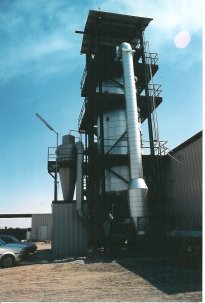|
The composition of Spirulina shows clearly that it is a
high protein content food with
important
amounts of vitamins, minerals,
and essential
non-saturated fatty acids but
low in calories.
Traditionally it has been eaten
in combination
with cereals, thus making it
an appropriate
food for treating protein-energy
malnutrition
.
If Spirulina is not to be eaten
immediately
at the production site, it should
be dried to a residual humidity content of 7% or less.
|
.
Earthrise Spray-dryier

|
|
Once dried and kept from oxidation and sunlight,
the product can be kept for long periods,
enabling stockage and distribution.
The equipment used for spray drying is costly and it requires major amounts (around
1 KWh per kilo of dried product)
of energy
to operate. We find that the
filter cake
instead of going through the
spray drying
process can be dried simply by
being mixed
with dry precooked cereal flour
such as wheat,
maize, millet, rice, oats, barley,
etc..
ln a properly designed mixer
the dry flour
pumps the water from the algae
cake within
about 5 seconds, leaving a perfectly
blended
mixture wïth only about 5 to
7% overall humidity.
|

IZMIR, Turkey, 26 October 2001
|
This breakthrough will make a complete food
enriched with Spirulina available to the
major food aid organizations of the world.
With the countries which are members of the Intergovernmental Spirulina Program asking for it, we should be seeing improvement
in child health and less and
less malnutrition
occuring in developing countries
So, Spirulina is a wonderful
microorganism
capable of being transformed
into a complete
food when mixed with cereals.
It has been
used to treat malnutrition victims
with success
in many countries: India, Senegal,
Togo,
Vietnam, Burkina Faso, Benin,
Central African
Repubic,Democratic Republic of
Congo, Brazil,
Cuba, China, ThaIland - to name
a few. More
than a thousand scientific articles
about
Spirulina have been published;
there are
20 or more books and more than
20 doctoral
theses devoted to Spirulina.
|
WEBMASTER Site'' http://Spirulina.online.fr
'' mailto:''Webmaster'' (Updated: November
2005)
|


